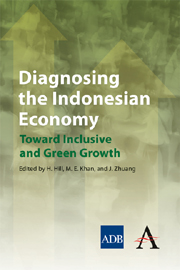Book contents
- Frontmatter
- Foreword
- Preface
- Author Profiles
- Abbreviations and Acronyms
- Contents
- 1 Introduction
- 2 Development Policies and Performance
- 3 Critical Constraints to Growth
- 4 Critical Constraints to Reducing Poverty and Inequality
- 5 Macroeconomic Management
- 6 Industrialization: Patterns, Issues, and Constraints
- 7 Infrastructure Development: Challenges and the Way Forward
- 8 Human Capital and Economic Development
- 9 Economic Growth, Employment Creation, and Poverty Alleviation
- 10 Poverty Reduction: The Track Record and Way Forward
- 11 Decentralization
- 12 Making Indonesia's Growth Green and Resilient
- Index
Foreword
Published online by Cambridge University Press: 05 May 2012
- Frontmatter
- Foreword
- Preface
- Author Profiles
- Abbreviations and Acronyms
- Contents
- 1 Introduction
- 2 Development Policies and Performance
- 3 Critical Constraints to Growth
- 4 Critical Constraints to Reducing Poverty and Inequality
- 5 Macroeconomic Management
- 6 Industrialization: Patterns, Issues, and Constraints
- 7 Infrastructure Development: Challenges and the Way Forward
- 8 Human Capital and Economic Development
- 9 Economic Growth, Employment Creation, and Poverty Alleviation
- 10 Poverty Reduction: The Track Record and Way Forward
- 11 Decentralization
- 12 Making Indonesia's Growth Green and Resilient
- Index
Summary
Indonesia has had a good performance on the economic and poverty fronts in recent years. Its economy has also managed the eff ects of the recent global economic crisis well, and has grown at relatively high rates compared with other major economies in Southeast Asia. Nevertheless, the country's development challenges remain daunting. Indonesia lags far behind Malaysia and Thailand in terms of per capita gross domestic product (GDP), and will need about two decades to double it if the economy maintains the average annual GDP growth rate recorded in the 2000s. The pace of poverty reduction needs to be accelerated for Indonesia to deliver on the targets set in the country's development plans. Deteriorating trends in the use of natural resources and the environment need to be checked and reversed. Studies indicate that over 5 million hectares of forest was lost during 2000–2005 and that over two-thirds of the country's coral reefs had lost at least half of their living corals by 2005.
This book presents findings of a country diagnostic study on Indonesia, a collaborative eff ort among the Asian Development Bank (ADB), the Government of Indonesia, the International Labour Organization, and the Islamic Development Bank. The study embodied a new paradigm on development planning, centered on the premise that the economic and political environments differ a great deal among countries, and there is no “one-size-fits-all” solution to development problems; thus, identifying the binding constraints to development and sequencing policy priorities contingent on country-specific circumstances are critical for igniting and sustaining growth and accelerating the pace of poverty reduction.
- Type
- Chapter
- Information
- Diagnosing the Indonesian EconomyToward Inclusive and Green Growth, pp. v - viPublisher: Anthem PressPrint publication year: 2012

